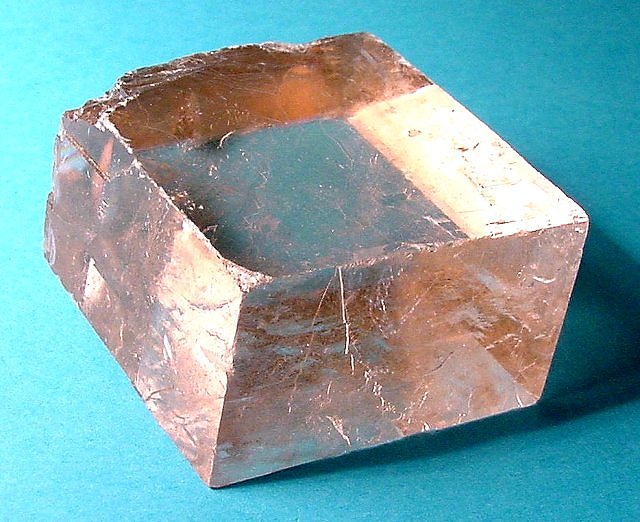| Crystal system | Hexagonal |
| Transparency | Transparent to opaque |
| Luster | Vitreous to silky |
| Fracture | Uneven to splintert |
| Cleavage | Perfect rhombohedral |
| Specific Gravity | 2.71 |
| Hardness | 3 |
| Optical Character | Uniaxial - ; Double Refractive |
| Refractive index | 1.486-1.658 |
| Birefringence | 0.172 |
| Dispersion | 0.017 |
| Fluorescence | Variable |
| Pleochroism | |
| Chemical Formula | CaCO3 |
| Comments | Effervesces with HCl |
| Streak | |
Calcite (KAL-site), which is a carbonate of calcium (CaCO3), is a very common transparent to opaque mineral that occurs in a wide range of colors and patterns. The name of the species comes from the Latin wording meaning "lime". Colorless, transparent material is know as Iceland spar and is used to illustrate high birefringence. Marble, which is metamorphosed limestone, is a massive crystalline aggregate. It is a well-known and widely used decorative stone; when banded, it is referred to correctly as onyx marble and incorrectly as "Oriental alabaster", "Mexican onyx", "California onyx", etc.. A fibrous type is known as satinspar (a similarly named variety exists for gypsum and aragonite). All varieties except Iceland spar can be dyed various colors; material dyed green and other jade colors is often sold unethically as "Mexican jade". A paramorph of calcite is aragonite; that is, both are CaCO3 (calcium carbonate), but calcite is hexagonal and aragonite is orthorhombic.
Calcite crystals exhibit a greater variety of forms and habits than any other mineral; more than 300 forms and 1000 combinations have been catalogued. Common shapes include rhombohedral, taublar, long prismatic, scalenohedral and twins. The mineral is so widespread that only a few of the major sources can be mentioned. Excellent crystals occur in Eskifiord, Iceland; Derbyshire, Cumberland, Devonshire; Durham and Lancashire, England; Andreasberg, Germany; Kapnik, Romania; Guanajuato, Mexico; Joplin, Missouri; St. Lawrence County, New York; and the Lake Superior copper district. Commercially significant deposits of decorative marble occur in Vermont, Tennessee, Alabama and Colorado.
The hardness of calcite is 3 on Mohs scale, the luster is vitreous (silky on satinspar), and the streak is white or grayish. Massive material has a granular, uneven fracture, but crystals show perfect rhombohedral cleavage; the extent to which it is apparent in the aggregate form depending on grain size. The fracture of satinspar is splintery. Specific gravity is about 2.71, and refractive index is 1.486 - 1.658, with a consequent birefringence of .172. The optic character is uniaxial negative. There are no characteristic inclusions. Although calcite is not fusible, it is attacked by acids, effervescing in HCl. Satinspar gypsym, which resembles the calcite variety, can be separated by its lack of effervescence and its lower hardness. The excessive birefringence also may be detected in the aggregate form by using the spot method of R.I. determination. Before the full birefringence can be obtained, however, it may be necessary to try different positions of the stone on the hemisphere and to rotate a Polaroid plate before the eyepiece of the instrument.
Because of its excellent three-directional cleavage, crystal calcite is very difficult to facet. Diamond bonded laps may be used for grinding; however, copper laps impregnated with diamond dust may cause difficulty. Polishing may be accomplished with Linde A on wax, pitch or wood laps. Step cuts are easier to fashion than round brilliants. 42° crown angles and 43° pavilion angles are recommended. Massive material, which is always carved or made into cabochons, presents little or no difficulty; it polishes well with tin oxide.


